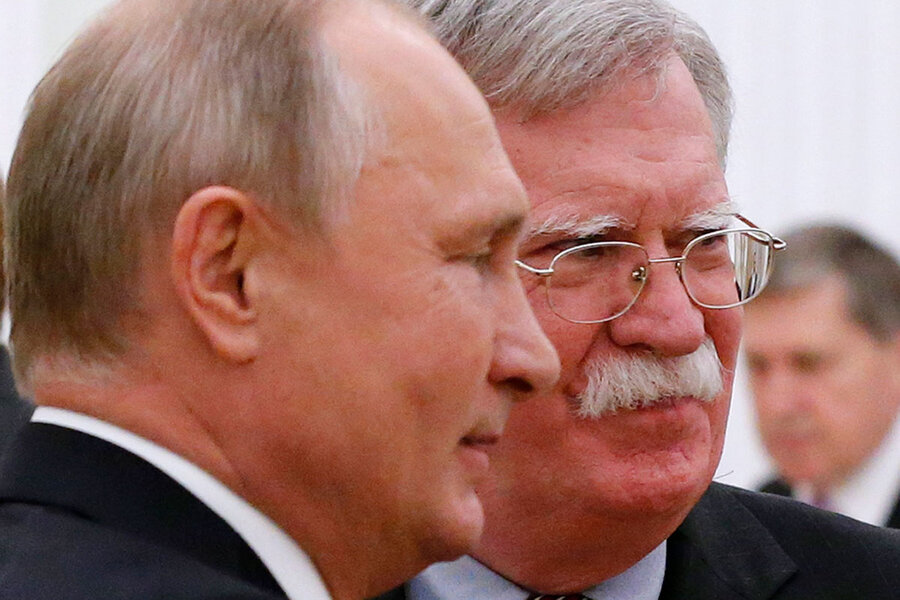A critical moment in the global effort to contain nuclear weapons
Loading...
| London
It might be called a tale of three treaties. The first is the 1987 Intermediate-Range Nuclear Forces treaty between the United States and the former Soviet Union. The US says it intends to pull out. The second is the 2015 international accord limiting Iran’s nuclear program. Next week, the US is expected to reimpose sanctions on Iranian oil exports. The third is a still-elusive deal to get North Korea to scrap its nuclear arms. At a critical period in efforts to contain nuclear weapons, the stakes are high: the prospect of a new superpower arms race, and the possible emergence of two more nuclear powers in North Korea and Iran. China looms large in the US desire to pull out of the INF treaty. The Iran controversy is less about nuclear arms than geopolitics; Iran has been testing new missiles and backing Syria and Hezbollah. Both moves hold implications for any deal with North Korea. The US may calculate its steps will strengthen its position with leader Kim Jong-un. But they could make Mr. Kim wonder if what Washington wants is not just a nonnuclear North Korea, but a non-Kim one.
Why We Wrote This
With three treaties in play for the US, some say the world could be poised for a new arms race. But if it is, the race would look very different from that between the US and the former USSR.
Not all arms-control agreements are created equal.
That’s adding further complexity, and uncertainty, to a critical period in world efforts to contain nuclear weapons. The stakes are high: the prospect of a new superpower arms race, and the possible emergence of two more nuclear powers in North Korea and Iran.
It might be called a tale of three treaties.
Why We Wrote This
With three treaties in play for the US, some say the world could be poised for a new arms race. But if it is, the race would look very different from that between the US and the former USSR.
The first is the 1987 Intermediate-Range Nuclear Forces Treaty between the United States and the Soviet Union. Last week, National Security Adviser John Bolton confirmed Washington’s intention to pull out. The second is the 2015 international accord limiting Iran’s nuclear program. Next week, the US will reimpose sanctions on Iranian oil exports, and attention will focus on whether, or how long, Tehran will choose to keep its nuclear program on hold.
The third is Mr. Trump’s still-elusive deal to get North Korea to scrap its nuclear arms.
For former Soviet leader Mikhail Gorbachev, who signed the 1987 treaty, US retreat from both it and the Iran accord are part of a bigger picture, in which the whole architecture of international arms control is coming under threat. He has warned of a “new arms race.”
And he may prove right. But the specifics of each of the arms-control deals now in the spotlight suggest that, if so, it’s likely to be different from the old US-Soviet variety.
In the 1970s, a main focus of nuclear tension was the Soviets’ deployment of a medium-range missile called the SS-20. Capable of hitting all of Europe, it threatened to “decouple” the United States from its NATO allies. If the Soviets launched SS-20s, the only response for the US would be an intercontinental strike. That raised the question of whether an American president would risk New York or Washington to protect Amsterdam or Bonn.
In December 1979, NATO responded by deciding to deploy similar US missiles in Europe. But the tension only truly subsided with the INF treaty: a first for arms control, because it didn’t just limit such ground-based weapons. It mandated their elimination.
So why does the US want out? The advertised catalyst is Russian President Vladimir Putin’s violation of the INF accord with a new cruise missile NATO calls the SSC-8. But there’s another reason, involving the country Washington sees increasingly as its true superpower rival: China. The INF treaty, to which China wasn’t a signatory, prevents the US from deploying medium-range ground weapons in Asia, where they form the backbone of the Chinese Army’s missile force.
The Iran controversy is less about nuclear arms than geopolitics. The agreement was a trade-off: strict limits, subject to UN inspections, on Iran’s development of a nuclear weapon for a period of 10 to 15 years, in exchange for billions of dollars freed up through the easing of sanctions. There’s been no evidence Iran is cheating. But it has been testing new missiles, as well as providing financial and military backing to Syria’s President Bashar al-Assad and the Lebanese-based Shiite militia Hezbollah – neither covered by the nuclear deal, but both seen by the US as part of an expanding Iranian threat in the Middle East.
Where the INF agreement and Iran come together is in their potential implications for an eventual deal with North Korea.
The Trump administration’s view seems to be that a tough response to Russia on the INF treaty, and withdrawal from a “bad deal” with Iran that left issues like missile development and Hezbollah unaddressed, will strengthen its position in nuclear talks with North Korean dictator Kim Jong-un. A move by the US to deploy ground missiles in Asia would also increase its military leverage.
Yet those messages could be received differently by North Korea and by China, whose support is almost certainly essential to a successful nuclear deal.
The Iran agreement is more restrictive, and its inspection regime more intrusive, than anything Kim Jong-un has so far been willing to countenance. And that agreement has been working. So the Americans’ withdrawal could be seen in Pyongyang as calling into question their trustworthiness as negotiating partners. A beefed-up US missile force might raise an even more serious question in Kim’s mind: whether what Washington really wants is not just a non-nuclear North Korea, but a non-Kim one.








